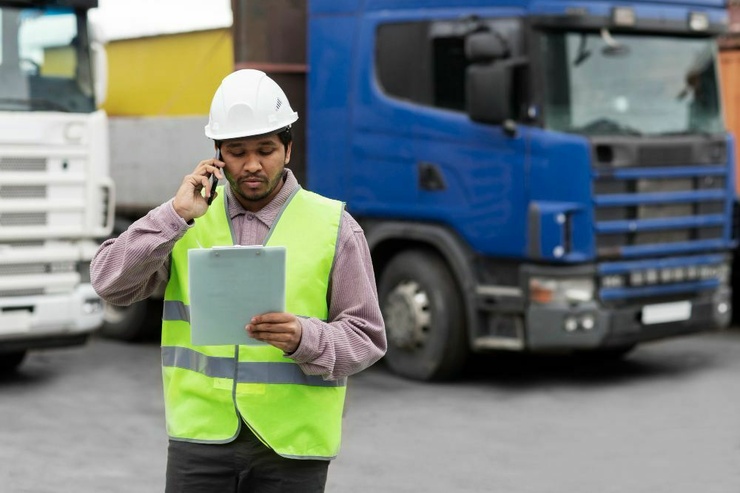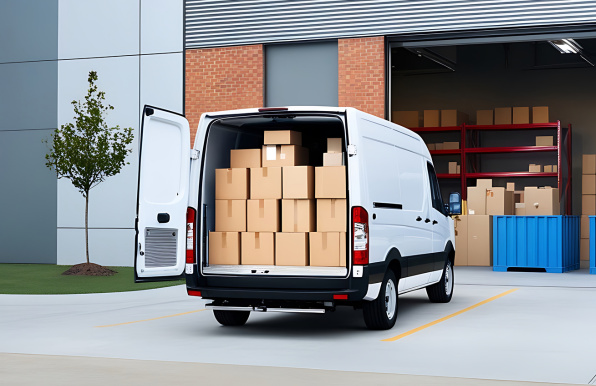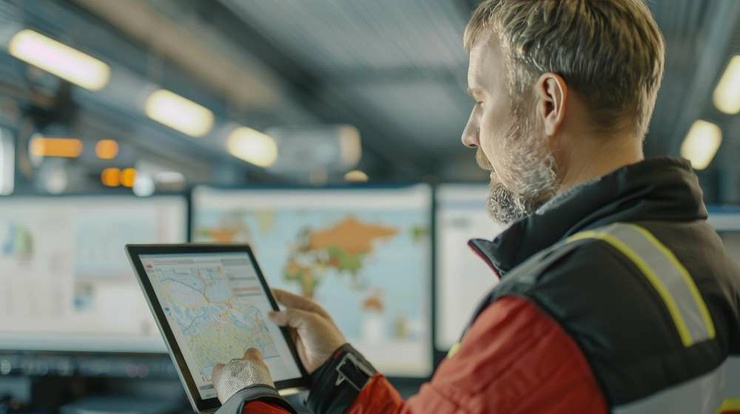- Last-Mile
Last-mile technology and how it impacts last-mile delivery
Table of Contents
- What is last-mile technology?
- What is the last-mile problem?
- How Amazon Leverages Last-mile Delivery for Its Logistics
- How Last-mile Technology Can Help Your Business
- What are some last-mile technology examples?
- How Technology Will Shape the Future of Last-mile Delivery
- How to use technology to improve last-mile delivery?

In logistics, the last mile is the final stage of the delivery journey, delivering a product from a company to the consumer, usually at their front door. Not only is the last mile the most critical to the consumer delivery experience, it is typically the most complex and expensive leg of the entire supply chain. Last-mile technology enhances last-mile delivery by pushing boundaries forward and enabling better deliveries and consumer experiences.
What is last-mile technology?
Last-mile technology includes a range of products and solutions that simplify and optimize the complex last mile, making deliveries more efficient and less costly while also providing a superior customer experience. Last-mile technology includes software platforms and delivery innovations, such as autonomous delivery vehicles (ADV), drones and robots, all working together to help reduce and eliminate delays.
Getting last-mile delivery right is important for brands in this e-commerce driven world. Businesses need the last mile to be fast and efficient to meet rising consumer expectations. Delivery has taken center stage as a key factor that consumers evaluate when they decide to make a purchase.
Last-mile management platforms allow companies to achieve a consistent, branded consumer experience with every purchase and every delivery. Key last-mile challenges include: routing, consumer experiences, omnichannel fulfillment, sustainability and returns.


What is the last-mile problem?
Last-mile operations have never been so complex as the world of e-commerce and delivery continues to change. Increased variables in how, where and when deliveries depart and arrive are giving shippers and carriers alike greater flexibility but they also provide greater complexity to the last mile.

With its ever-increasing ability to deliver in shorter time frames, Amazon has set the bar high for all companies to be able to deliver quickly while notifying the consumer about transit delivery details. Brands strive to live up to the “Amazon effect,” while adhering to the promised delivery date and time.
Consumers want visibility into their deliveries but they also expect faster delivery speeds. Keeping all stakeholders happy while delivering in increasingly shorter time frames contributes to the overall challenges.
In short, the last-mile delivery problem impacts all companies. In today’s world, every company wants to deliver products quickly, efficiently and provide superior customer experiences while working in an increasingly complex and competitive landscape.
How Amazon Leverages Last-mile Delivery for Its Logistics
How did Amazon leverage last-mile to create its logistics network and become a leader in the last mile delivery? The journey to last-mile leadership happened over many years and with the help of several innovative strategies.
In 2009, Amazon announced same-day deliveries in metro areas like New York, Philadelphia, Washington, DC, Seattle, Baltimore and Las Vegas. They charged a nominal fee to Amazon members and slightly more to non-members. They were able to service these large metropolitan areas with same-day delivery before the rest of the retail world even understood how to achieve same-day delivery.
In 2014, Amazon bought stakes in two companies to expand their last-mile transportation network and in 2015, Amazon launched Amazon Prime Now. Amazon had to create 58 delivery hubs across the United States in order to be able to guarantee deliveries within one to two hours. Amazon Prime Now was initially limited to big cities with a limited number of items available for immediate shipping, but it represented a huge step forward in creating consumer demand for almost-immediate deliveries.
Prime Now is available to members who pay a flat fee each year to enable two-day shipping, free one-day shipping and in some zip codes, same-day shipping. Prime Now offers specific items that ship from early morning to late evening, seven days a week and they are delivered by Prime Now employees, as opposed to FedEx, UPS or other shipping companies. When a customer completes an order, Amazon provides real-time fulfillment updates via SMS texts.
In 2018, Amazon created its own last-mile delivery service with Amazon Logistics to reduce their fulfillment and shipping costs. Amazon now had the ability to control the schedules and costs with its own fleet.
In the near future, Amazon will expand to drone delivery under the label of Prime Air, promising delivery within 30 minutes. Amazon’s goal is to deliver packages weighing up to five pounds in less than an hour.
Amazon’s success creating its own last-mile transportation system has meant consumers now take the Amazon effect for granted and expect all companies to provide fast, convenient shipping with visibility into order status. Brands and companies can replicate the Amazon effect by investing in last-mile management platforms so they can provide superior customer experiences.
How Last-mile Technology Can Help Your Business
Last-mile technology continues to evolve as it adapts to changing consumer expectations. How can utilizing a last-mile management platform improve your deliveries?
A last mile management platform empowers businesses to cater to ever-growing consumer expectations while achieving operational efficiency. It keeps costs in check, provides a range of operations like delivery scheduling, task allocation, routing, real-time tracking and tracing. It also enables gig-fleets, carrier networks, increased sustainability and efficient omnichannel distribution.
Last-mile platforms help companies with route optimization. Platforms improve routes through the use of artificial intelligence (AI) and machine learning (ML) to create dynamic routes optimized throughout each day. AI and ML takes into account weather, traffic patterns, and vehicle capacity to help recommend the most efficient delivery routes daily.
Real-time dynamic routing also helps improve fleet utilization and driver planning and can reduce miles driven per driver. Managers can utilize the platform to assign drivers delivery and returns pickup routes based on driver locations and recipient addresses.
Delivery scheduling becomes efficient and allows end consumers to choose their delivery preferences. A last-mile platform can offer consumers flexible time slots, pick-up and drop-off points and the ability to leave special delivery instructions for drivers. Drivers can receive communications from package recipients if plans change and use SMS alerts to notify recipients when their packages arrive.
Providing real-time visibility to every stakeholder in the delivery process, whether they are a carrier, a retailer or a consumer, allows everyone to pinpoint an order’s location and know when it will be delivered. This knowledge can reduce calls to customer service centers asking where is my order (WISMO), saving time and reducing cost for the company.
A last-mile management platform can also enable real-time tracking and tracing of a package. Visibility provides the manager the ability to identify any issues with the delivery and provides actionable insights into any potential exceptions. Providing visibility to the customer via SMS alerts helps drivers complete first attempt deliveries, reducing failed deliveries. Proof of delivery is offered as well through photos of the packages at the front door and helps contribute to positive customer experiences.
Last-mile technology can help companies unify and manage multiple carrier fleets and integrate them into one system, so logging into multiple systems to view carrier status is no longer necessary. This creates a simplified way to gain knowledge of all the fleets utilized by a company, whether owned or not.


What are some last-mile technology examples?
Disruptions over the past few years have led to a quickened pace of enhancements to last-mile delivery technology.
Amazon conditioned all consumers to expect quick deliveries in ever-decreasing time periods. Not only did they teach us to expect deliveries in two days, one day, same day and now within a few hours, they also taught consumers to demand that type of service from every type of retailer.
Companies utilizing last-mile technology are food delivery apps such as UberEats, DoorDash, Postmates and Grubhub. They all created ways to deliver food quickly and allow customers to track their deliveries visually through maps. These companies can also tap into gig-drivers utilizing last-mile technology.
Ridesharing apps like Uber and Lyft communicate not only their driver’s positions once consumers have ordered a ride, but they allow consumers to communicate with those drivers via SMS texts.
Last-mile technology has changed the ways consumers view deliveries and have set their expectations high. Companies that use last-mile technology to shape their deliveries will be able to create better consumer experiences and retain customers.
How Technology Will Shape the Future of Last-mile Delivery
As technology continues to change and evolve, new ways of meeting consumer demands will develop. Today there are many new technologies shaping delivery in the last mile.
- Electric vehicles (EVs) will help transform deliveries. Cities worldwide are creating regulations to limit vehicle emissions, so EV fleets are a cost-effective solution to meeting those regulations. The challenge with EVs is creating charging stations throughout both urban and more rural areas. Urban areas may see the adoption of EV fleets sooner since some areas do not have the infrastructure necessary to create charging stations.

- Drones sound like science fiction but they are being piloted in programs across the world. The U.S.Federal Aviation Administration (FAA) has given drones clearance for deliveries and Amazon will run a pilot using drones for deliveries in California in the second half of 2022.
- Autonomous delivery vehicles are self-driving vehicles that can make last-mile deliveries without the need for humans. FedEx and Volkswagen have used autonomous vehicles for delivery in China and Germany. The U.S. Postal Service hopes to have autonomous vehicles online by 2025 to help deliver on over 25,000 rural routes Autonomous vehicles can also have delivery people on board, where the vehicles provide the driving and drop the delivery person at an address and continue on to an alternate address to pick them up, eliminating the need for parking. In more controlled settings, robots are also being used to make deliveries, though they still need to learn to navigate crowded settings.
- Warehouse robots that can pack and pick items for shipment will help with fulfillment. Also known as autonomous pickers, these robots use radio frequency identification (RFID) to transfer data from a tag attached to an object, to automatically identify and track items. These robots can help prepare items for shipment from warehouses and reduce the amount of human labor needed in warehouses.
Read our next blog on Big & bulky last-mile delivery - how hard could it be?
How to use technology to improve last-mile delivery?
How can companies use technology to improve their deliveries? Companies need to dramatically simplify the most complicated aspects of delivery logistics, especially in the last mile. They must optimize their end-to-end omnichannel fulfillment with precision while minimizing last-mile costs. Simplified orchestration from order to delivery through dynamic routing, managing outsourced fleets, scheduling and last mile tracking is key, while also providing real-time visibility to all stakeholders.
FarEye, an intelligent delivery management platform helps companies provide a cohesive experience from order to delivery by creating simplified, efficient and cost-effective deliveries that increase consumer satisfaction and brand loyalty. FarEye’s intelligent delivery management platform simplifies delivery logistics throughout the entire delivery journey.
FarEye provides a wide scope of operations support such as real-time dynamic routing to optimize routes throughout the day, loop optimization using AI based recommendations based on past performance. delivery scheduling, and provides real-time visibility to all stakeholders. FarEye’s intelligent delivery management platform also provides orchestration and real-time visibility to simplify complex last-mile deliveries.
One of FarEye’s clients grew their sales by 8.6% in one year by adding digital last-mile capabilities. FarEye has also helped a leading furniture retailer achieve a 97% increase in ETA accuracy by providing flexibility for customers to pick delivery slots and creating dispatch scheduling and routing automation based on customer choices.
Companies that utilize last-mile technology can gain long-term competitive advantages to keep consumers satisfied.



Komal Puri is a seasoned professional in the logistics and supply chain industry. As the AVP of Marketing and a subject matter expert at FarEye, she has been instrumental in shaping the industry narrative for the past decade. Her expertise and insights have earned her numerous awards and recognition. Komal’s writings reflect her deep understanding of the industry, offering valuable insights and thought leadership.
Let's Talk to Our Experts and Optimize Your Deliveries Today!
An expert from our team will reach out within 24 hours
Related resources


